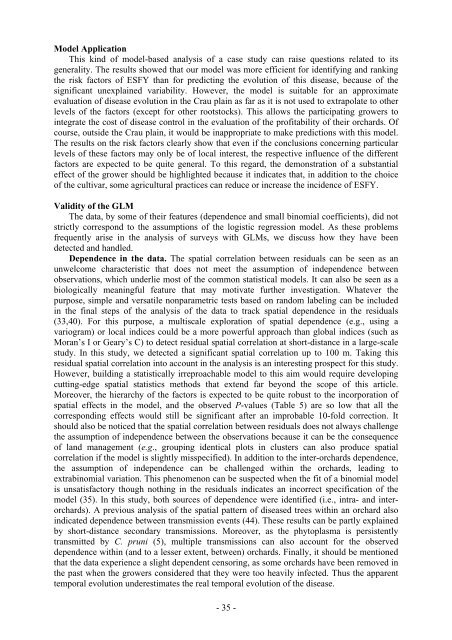Ecole Nationale Supérieure Agronomique de Montpellier ... - CIAM
Ecole Nationale Supérieure Agronomique de Montpellier ... - CIAM
Ecole Nationale Supérieure Agronomique de Montpellier ... - CIAM
Create successful ePaper yourself
Turn your PDF publications into a flip-book with our unique Google optimized e-Paper software.
Mo<strong>de</strong>l Application<br />
This kind of mo<strong>de</strong>l-based analysis of a case study can raise questions related to its<br />
generality. The results showed that our mo<strong>de</strong>l was more efficient for i<strong>de</strong>ntifying and ranking<br />
the risk factors of ESFY than for predicting the evolution of this disease, because of the<br />
significant unexplained variability. However, the mo<strong>de</strong>l is suitable for an approximate<br />
evaluation of disease evolution in the Crau plain as far as it is not used to extrapolate to other<br />
levels of the factors (except for other rootstocks). This allows the participating growers to<br />
integrate the cost of disease control in the evaluation of the profitability of their orchards. Of<br />
course, outsi<strong>de</strong> the Crau plain, it would be inappropriate to make predictions with this mo<strong>de</strong>l.<br />
The results on the risk factors clearly show that even if the conclusions concerning particular<br />
levels of these factors may only be of local interest, the respective influence of the different<br />
factors are expected to be quite general. To this regard, the <strong>de</strong>monstration of a substantial<br />
effect of the grower should be highlighted because it indicates that, in addition to the choice<br />
of the cultivar, some agricultural practices can reduce or increase the inci<strong>de</strong>nce of ESFY.<br />
Validity of the GLM<br />
The data, by some of their features (<strong>de</strong>pen<strong>de</strong>nce and small binomial coefficients), did not<br />
strictly correspond to the assumptions of the logistic regression mo<strong>de</strong>l. As these problems<br />
frequently arise in the analysis of surveys with GLMs, we discuss how they have been<br />
<strong>de</strong>tected and handled.<br />
Depen<strong>de</strong>nce in the data. The spatial correlation between residuals can be seen as an<br />
unwelcome characteristic that does not meet the assumption of in<strong>de</strong>pen<strong>de</strong>nce between<br />
observations, which un<strong>de</strong>rlie most of the common statistical mo<strong>de</strong>ls. It can also be seen as a<br />
biologically meaningful feature that may motivate further investigation. Whatever the<br />
purpose, simple and versatile nonparametric tests based on random labeling can be inclu<strong>de</strong>d<br />
in the final steps of the analysis of the data to track spatial <strong>de</strong>pen<strong>de</strong>nce in the residuals<br />
(33,40). For this purpose, a multiscale exploration of spatial <strong>de</strong>pen<strong>de</strong>nce (e.g., using a<br />
variogram) or local indices could be a more powerful approach than global indices (such as<br />
Moran’s I or Geary’s C) to <strong>de</strong>tect residual spatial correlation at short-distance in a large-scale<br />
study. In this study, we <strong>de</strong>tected a significant spatial correlation up to 100 m. Taking this<br />
residual spatial correlation into account in the analysis is an interesting prospect for this study.<br />
However, building a statistically irreproachable mo<strong>de</strong>l to this aim would require <strong>de</strong>veloping<br />
cutting-edge spatial statistics methods that extend far beyond the scope of this article.<br />
Moreover, the hierarchy of the factors is expected to be quite robust to the incorporation of<br />
spatial effects in the mo<strong>de</strong>l, and the observed P-values (Table 5) are so low that all the<br />
corresponding effects would still be significant after an improbable 10-fold correction. It<br />
should also be noticed that the spatial correlation between residuals does not always challenge<br />
the assumption of in<strong>de</strong>pen<strong>de</strong>nce between the observations because it can be the consequence<br />
of land management (e.g., grouping i<strong>de</strong>ntical plots in clusters can also produce spatial<br />
correlation if the mo<strong>de</strong>l is slightly misspecified). In addition to the inter-orchards <strong>de</strong>pen<strong>de</strong>nce,<br />
the assumption of in<strong>de</strong>pen<strong>de</strong>nce can be challenged within the orchards, leading to<br />
extrabinomial variation. This phenomenon can be suspected when the fit of a binomial mo<strong>de</strong>l<br />
is unsatisfactory though nothing in the residuals indicates an incorrect specification of the<br />
mo<strong>de</strong>l (35). In this study, both sources of <strong>de</strong>pen<strong>de</strong>nce were i<strong>de</strong>ntified (i.e., intra- and interorchards).<br />
A previous analysis of the spatial pattern of diseased trees within an orchard also<br />
indicated <strong>de</strong>pen<strong>de</strong>nce between transmission events (44). These results can be partly explained<br />
by short-distance secondary transmissions. Moreover, as the phytoplasma is persistently<br />
transmitted by C. pruni (5), multiple transmissions can also account for the observed<br />
<strong>de</strong>pen<strong>de</strong>nce within (and to a lesser extent, between) orchards. Finally, it should be mentioned<br />
that the data experience a slight <strong>de</strong>pen<strong>de</strong>nt censoring, as some orchards have been removed in<br />
the past when the growers consi<strong>de</strong>red that they were too heavily infected. Thus the apparent<br />
temporal evolution un<strong>de</strong>restimates the real temporal evolution of the disease.<br />
- 35 -



